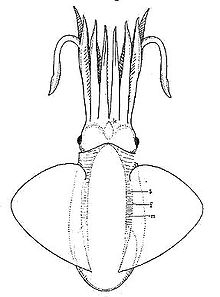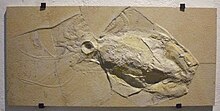Loading AI tools
Genus of fossil cephalopod From Wikipedia, the free encyclopedia
Trachyteuthis is a genus of extinct octopodiform cephalopods, comprising six species: T. hastiformis, T. latipinnis, T. nusplingensis, T. teudopsiformis,[2] T. covacevichi[3] and T. chilensis.[1]
| Trachyteuthis Temporal range: | |
|---|---|
 | |
| Reconstruction of Trachyteuthis hastiformis | |
 | |
| Trachyteuthis hastiformis, Jura Museum | |
| Scientific classification | |
| Kingdom: | |
| Phylum: | |
| Class: | |
| Subclass: | |
| Superorder: | |
| Order: | |
| Family: | Trachyteuthididae Naef, 1922 |
| Subfamily: | Trachyteuthidinae Naef, 1921 |
| Genus: | Trachyteuthis Meyer, 1846 |
| Species | |
| |
The taxonomic placement of Trachyteuthis is uncertain. Though often assigned to the order Vampyromorphida, the discovery of fossilised Trachyteuthis beaks in the Upper Jurassic limestone of Germany suggests a close phylogenetic relation to the Octopoda.[4][5] It is clear that it does at least belong in the Coleoidea.[2] It is thought to be very closely related to Teudopsis.[3]
Fossils are scarce but have been reported from the Kimmeridge clay of the UK; the Solnhofen limestone of Germany, Jurassic deposits in Antarctica,[6] and Oxfordian deposits in Chile.[3]

First described in 1773 as the remnants of a fish, Trachyteuthis was considered comparable to a Sepia cuttlebone by Rüppell in 1829. A separate genus was erected for the material in 1846 by Meyer.[2] English material discovered in 1855 was termed Coccoteuthis latipinnis; this was later synonymised with the identical Solnhofen deposits. A 2007 survey of museum collection established that there were ground for the erection of three species within the genus.[2]
Seamless Wikipedia browsing. On steroids.
Every time you click a link to Wikipedia, Wiktionary or Wikiquote in your browser's search results, it will show the modern Wikiwand interface.
Wikiwand extension is a five stars, simple, with minimum permission required to keep your browsing private, safe and transparent.